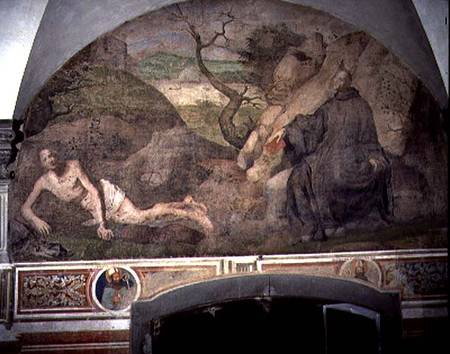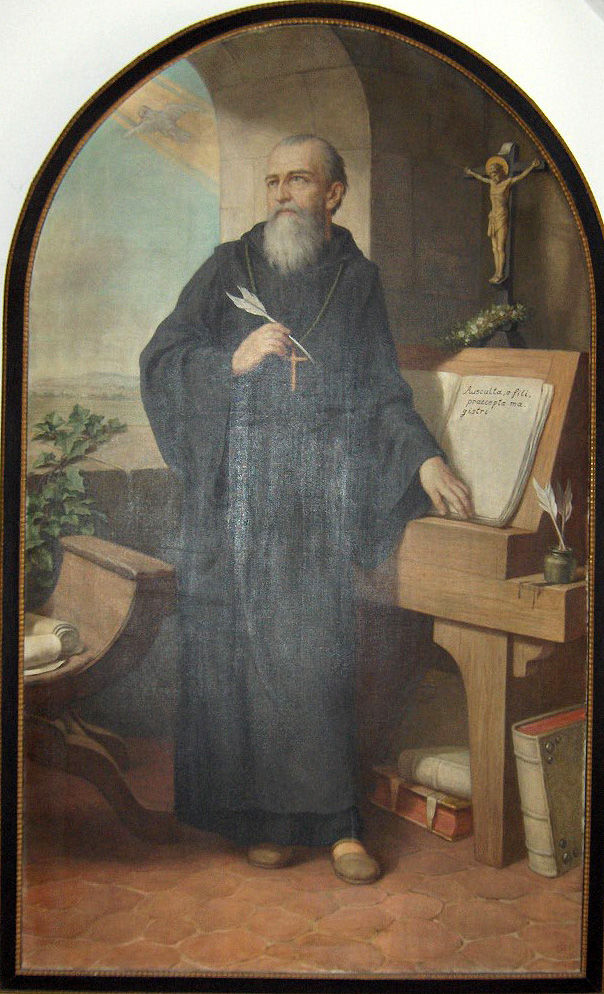Thursday, June 9th, 2011
St. Benedict and Thornbushes
I have a new appreciation for St. Benedict of Nursia (480-547 CE) this afternoon, just having spent a few hours pulling wild thornbushes out of my backyard. I think that is the most grueling and painful exercise I have ever had while gardening, even though I was equipped with gloves and protective clothing. But back to St. Benedict: while battling these bushes, I couldn’t help but think of the the saint. According to legend, Benedict cast himself into a thorn bush while naked, to escape the wily temptation of a woman.
When I discuss Benedict in my art classes, I sometimes joke with my students that the thornbush experience was the early equivalent to “taking a cold shower” today. (And it was, at least for some monks!) But since this morning I have a new appreciation for thornbush hoppers. Anyone who willingly throws himself into a thornbush – with the intent of getting pricked – deserves sainthood in my opinion. Definitely.
I thought it would be fun to post some images of Benedict and the thornbush. I was only familiar with a few examples before writing this post, and frankly, I’ve been surprised that I can’t find more works of art dedicated to this legend online. Perhaps monastics wanted to remember that Benedict overcame temptation, but not necessarily focus on exactly how he overcame temptation? Or perhaps there are more images that exist, but they are cloistered away from the public eye? Any medievalists have thoughts on this topic?




I didn't know this legend and I found it bery interesting. Thank you!
Interesting post M!
My iconography of sacred subjects is not as strong as my observance of storks and pelicans(!), but I imagine the allusion to thorns in these saintly depictions is also designed as an illustration of someone who aims to have lived in a manner both emulating and serving Christ – himself crowned with thorns.
H
It's surprisingly difficult to find good-quality images of medieval abbey and church art on the interwebz–or that's been my experience anyway. I remember that first image you showed of the relief carvings on the capital from a seminar I took on pilgrimage art. Were there any pilgrimages associated w/the remains of Benedict? Maybe you'll have more luck trying to find image through that route.
I've been to the monastery at Subiaco, but knew little about it at the time. Wish I could go back now!
The thorns and roses mentioned in the St. Francis story work perfectly with the idea of lust and punishment, beauty and penance, pleasure and pain.
Thanks for the comments!
H: Yes! The imagery of thorns is often connected with Christ (and Christlike individuals) because of the crown of thorns. That's why I think this Minneapolis Institute of Arts idea is so interesting: I've never come across any other symbolic association for thorns beyond that of Christ.
heidenkind: That's an interesting thought about pilgrimages and Benedict! I'm not familiar with any pilgrimages associated with him, but I do know that Benedictine imagery exists at St.-Madeline at Vezelay (which was the starting point for one of the four major routes that pilgrims could follow to Santiago della Compostella). I actually show my medieval students images of Benedict from that church. There are some great images of capitals that show the devil bringing a woman to tempt Benedict (see one example here. My students and I discuss how images of women were quite often associated with unchastity or vice in the 11th century. Anyhow, I think it's likely that there is a capital at Vezelay which shows Benedict with the thornbush, but I haven't ever come across one in publications or image databases.
Val S: I'm jealous that you've been to Subiaco! Your thematic parallels between roses and thorns are perfect – I completely agree.